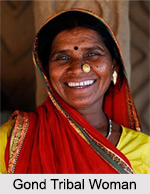 Gond Tribe or Gond Adivasi people are spread all over the Indian states of Madhya Pradesh, eastern Maharashtra, Chhattisgarh, Uttar Pradesh, Telangana, Andhra Pradesh, Bihar and Odisha. They speak Dravidian and they are listed in the Schedule Tribe category. Gond Tribe earlier was known as Raj Gond, but later the name became obsolete due to political eclipse of the Gond Rajas. The word Gond has been derived from the Telegu word Konda, which means hill. According to the 1971 census, Gond tribe"s population was 5.01 million. By the 1991 census, this had increased to 9.3 million and by the 2001 census the figure was nearly 11 million. Gond is the largest tribal community of the Central India.
Gond Tribe or Gond Adivasi people are spread all over the Indian states of Madhya Pradesh, eastern Maharashtra, Chhattisgarh, Uttar Pradesh, Telangana, Andhra Pradesh, Bihar and Odisha. They speak Dravidian and they are listed in the Schedule Tribe category. Gond Tribe earlier was known as Raj Gond, but later the name became obsolete due to political eclipse of the Gond Rajas. The word Gond has been derived from the Telegu word Konda, which means hill. According to the 1971 census, Gond tribe"s population was 5.01 million. By the 1991 census, this had increased to 9.3 million and by the 2001 census the figure was nearly 11 million. Gond is the largest tribal community of the Central India.
History of Gond Tribe
Scholars believe that Gond people ruled in Gondwana between the 13th and 19th centuries AD. Gondwana currently comes under the eastern part of Madhya Pradesh and the western part of Odisha. Some Muslim writers mark the 14th century as the rise of the Gond tribe. Gond people ruled in four kingdoms and those are Garha-Mandla, Deogarh, Chanda, and Kherla. They built number of forts, palaces, temples, tanks and lakes during their reign. Gondwana kingdom also gained control over the Malwa region after the decline of the Mughals followed by the Marathas in 1690. Gondwana dynasty survived until the late 16th century.
Concept of Religion for Gond Tribe
Ancient Gonds believed on many astronomy ideas. They had their own local terms for the Sun, Moon, constellations and Milky Way. Most of these ideas were based on their time-keeping and activities of calendar. Most of the Gond tribal people follow the folk Hinduism. Gonds worship Baradeo, whose alternate names are Bhagavan, Sri Shambu Mahadeo, and Persa Pen. Baradeo oversees the activities of lesser Gods such as clan and village deities, as well as ancestors. Many Gonds worship Ravana and Kupar Lingo. Gond people consider the concept of death as a magical deed of a demon. Pola, a cattle festival, Naga panchami and Dassera are the major festivals of Gond tribe.
Occupation of Gond Tribe
Prime occupation of Gond tribal people is agriculture; most of the Gond people are mainly farmers. Along with agriculture, they also herd cattle for their livelihood. Some of them have risen to the status of landowners and laborers.
Food and Beverage of Gond Tribe
Staple food known as Kodo and Kutki are the prime foods of Gond people. Vegetables are grown in kitchen gardens or collected from forests. Gond people grow their own tobacco for smoking and they make liquor out of Mahua tree.





















